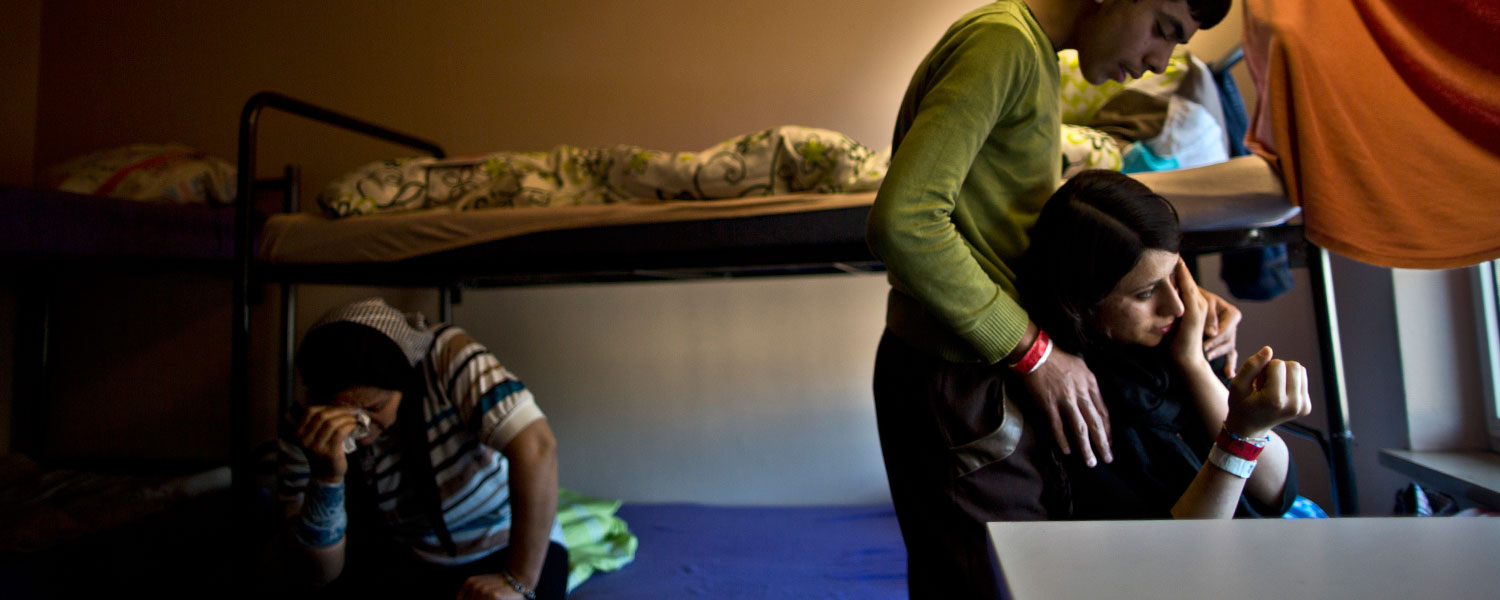
<p>In this Thursday, Dec. 10, 2015 photo, Delphine Qasu, 18, right, a Yazidi refugee from Sinjar, Iraq, is comforted by her brother Dilshad, 17, while crying after talking about their journey to reach Germany, at their new temporary home at Patrick Henry Village, in Heidelberg, Germany. The Qasus do not normally cry, but this felt nothing like normal. Like hundreds of thousands before them and untold more to come, the Iraqi family had just completed a disorienting dash across Europe and found refuge in Germany. (AP Photo/Muhammed Muheisen)</p>
Conflicts around the globe—especially those in Syria, Afghanistan, Iraq, and Somalia—are forcing millions to leave their homes in search of a safer, productive life in a new community.
The United States and Germany rank first and second in the number of foreign-born persons residing within their borders, with both experiencing increased migration over the past four decades. They have different histories of migration and immigrant integration, but decisions about immigration, asylum, and refugee policies are set at the national level in both countries. But for the most part, localities bear the day-to-day responsibility of integrating foreign-born newcomers of all legal statuses—and reap the potential benefits. They can learn from each other’s experiences.

From the national to the local
In 2015, more than one million migrants and asylum seekers made their way to Germany, where local governments, nonprofits, and volunteers have provided immediate assistance to migrants.
The United States sees approximately one million immigrants arrive every year as legal permanent residents and temporary workers admitted under standard immigration policy. But it has been unaccustomed to large numbers of asylum seekers simply showing up. Instead, refugees are more likely to arrive after living in a country of first asylum and after a lengthy vetting process. The number of admitted refugees is set annually and at the national level (85,000 in fiscal year 2016).
In the past several years, in a trend more comparable to Germany’s experience with asylum seekers, migrants fleeing violence in Central America have been arriving at the US-Mexico border unannounced, challenging the capacity of the US system to adjudicate their cases. Many places across the country have been unprepared for their arrival in schools, health care facilities, and neighborhoods.
Refugees, asylum seekers, and other immigrants come to cities and towns where local governments and nonprofits often coordinate tailored services to support them, such as housing, job training, and English-language classes.
What can US and German cities learn from each other?
The Urban Institute (in collaboration with the American Institute for Contemporary German Studies and Welcoming America) recently brought together mayors, municipal staff, and practitioners from German and US cities to talk about their efforts to handle incoming refugees, asylum seekers, and other immigrants; their decisions to take a welcoming stance toward these newcomers; and integration programs and policies that have been initiated.
German cities face short-term stresses in meeting the immediate needs of unexpected new arrivals. One of the biggest challenges is the angry public response to the huge numbers of asylum seekers and migrants arriving over the past year, stoking security, cultural, and economic fears. In many locales, political and civic leaders have decided to take a public welcoming stance and are joined by the energy of nonprofits and volunteers that work closely with asylum seekers to help them secure housing and get them acquainted with their new lives.
In places where the issue has been tense, important first steps include holding community meetings where long-term residents have their voices heard, brokering intercultural discussion groups, engaging volunteer residents and newcomers in informal language training, and providing introductions to local services such as bicycle sharing.
Ultimately, cities with asylum seekers face longer-term integration challenges that include providing language training and education, and helping these newest newcomers find jobs. These processes are emblematic of more typical immigrant newcomers, like the majority of those arriving in the United States and Germany, but with a daunting scale and pace.
In the United States, state and local governments have sought to control immigration through legislation within their jurisdictions. Places with a welcoming stance have service infrastructures to support immigrant newcomers, especially in cities with long-established immigrant communities, such as Los Angeles and New York. In cities where refugees are resettled, such as Baltimore and St. Louis, local organizations work directly with government agencies to provide services on the ground.
Many cities have passed welcoming initiatives or developed local welcoming plans to publicly signal a strong stance on immigrants’ place in their communities. Other places seek to deflect or exclude immigrants by way of housing, higher education, and licensing policies, leading to widely varying immigration policy contexts across states and localities.
But the long-term integration prospects potentially outweigh the immediate consequences, especially for aging societies like the United States and Germany. These new residents and their children should be viewed as assets that can benefit local labor markets, rejuvenate flagging housing markets, and provide civic and cultural benefits. Cities that have embraced immigrants and refugees, and view their inclusion as a positive force, are thriving.
Let’s build a future where everyone, everywhere has the opportunity and power to thrive
Urban is more determined than ever to partner with changemakers to unlock opportunities that give people across the country a fair shot at reaching their fullest potential. Invest in Urban to power this type of work.